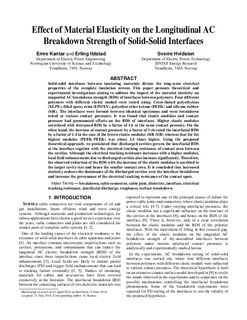| dc.contributor.author | Kantar, Emre | |
| dc.contributor.author | Ildstad, Erling | |
| dc.contributor.author | Hvidsten, Sverre | |
| dc.date.accessioned | 2019-04-11T06:07:18Z | |
| dc.date.available | 2019-04-11T06:07:18Z | |
| dc.date.created | 2019-03-07T10:25:51Z | |
| dc.date.issued | 2019 | |
| dc.identifier.citation | IEEE transactions on dielectrics and electrical insulation. 2019, 26 (2), 655-663. | nb_NO |
| dc.identifier.issn | 1070-9878 | |
| dc.identifier.uri | http://hdl.handle.net/11250/2594111 | |
| dc.description.abstract | Solid-solid interfaces between insulating materials dictate the long-term electrical properties of the complete insulation system. This paper presents theoretical and experimental investigations aiming to address the impact of the material elasticity on tangential AC breakdown strength (BDS) of interfaces between polymers. Four different polymers with different elastic moduli were tested using: Cross-linked polyethylene (XLPE), filled epoxy resin (EPOXY), polyether ether ketone (PEEK) and silicone rubber (SiR). The interfaces were formed between identical specimens and were breakdown tested at various contact pressures. It was found that elastic modulus and contact pressure had pronounced effects on the BDS of interfaces. Higher elastic modulus correlated with decreased BDS by a factor of 1.6 at the same contact pressure. On the other hand, the increase of contact pressure by a factor of 3 elevated the interfacial BDS by a factor of 1.4 in the case of the lowest elastic modulus (SiR-SiR) whereas that for the highest modulus (PEEK-PEEK) was about 2.4 times higher. Using the proposed theoretical approach, we postulated that discharged cavities govern the interfacial BDS at the interface together with the electrical tracking resistance of contact area between the cavities. Although the electrical tracking resistance increases with a higher modulus, local field enhancements due to discharged cavities also increase significantly. Therefore, the observed reduction of the BDS with the increase of the elastic modulus is ascribed to the larger cavity size and hence the smaller contact area. It is concluded that increased elasticity reduces the dominance of the discharged cavities over the interface breakdown and increase the governance of the electrical tracking resistance of the contact spots. | nb_NO |
| dc.language.iso | eng | nb_NO |
| dc.publisher | Institute of Electrical and Electronics Engineers (IEEE) | nb_NO |
| dc.subject | Elkraft | nb_NO |
| dc.subject | Electrical power engineering | nb_NO |
| dc.title | Effect of Material Elasticity on the Longitudinal AC Breakdown Strength of Solid-Solid Interfaces | nb_NO |
| dc.type | Journal article | nb_NO |
| dc.type | Peer reviewed | nb_NO |
| dc.description.version | acceptedVersion | nb_NO |
| dc.subject.nsi | VDP::Plast- og komposittmaterialer: 523 | nb_NO |
| dc.subject.nsi | VDP::Polymer and plastics: 523 | nb_NO |
| dc.source.pagenumber | 655-663 | nb_NO |
| dc.source.volume | 26 | nb_NO |
| dc.source.journal | IEEE transactions on dielectrics and electrical insulation | nb_NO |
| dc.source.issue | 2 | nb_NO |
| dc.identifier.doi | 10.1109/TDEI.2019.008087 | |
| dc.identifier.cristin | 1682825 | |
| dc.relation.project | Norges forskningsråd: 228344 | nb_NO |
| dc.description.localcode | © 2019 IEEE. Personal use of this material is permitted. Permission from IEEE must be obtained for all other uses, in any current or future media, including reprinting/republishing this material for advertising or promotional purposes, creating new collective works, for resale or redistribution to servers or lists, or reuse of any copyrighted component of this work in other works. | nb_NO |
| cristin.unitcode | 194,63,20,0 | |
| cristin.unitname | Institutt for elkraftteknikk | |
| cristin.ispublished | true | |
| cristin.fulltext | preprint | |
| cristin.qualitycode | 2 | |
